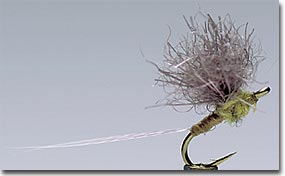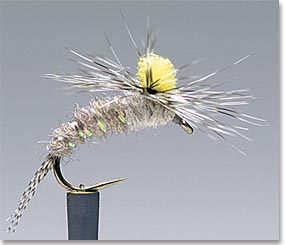Caddis
wanna be fly fisher.
It's been proven over the years that the Comparadun style dry fly's have consistently outfished the Catskill style flies, but why?
A Catskill style dry fly sits above the water film. This leads the trout to believe that the Dun has fully emerged and is about to take off. Trout as we know, like to use as little energy as possible to capture their prey so why take a chance of waisting good energy for something that may not be there when he opens his mouth.
Trout don't have to move around so much when spinners are all over the waters surface. For this reason is why so many anglers wait for a spinner fall not even realizing the potential of using a Comparadun anytime, even when there is no real hatch happening at the time. Many anglers aren't aware of the potential the Comparadun style dry fly has to offer, or just simply choose not to use them. I'll have to admit that I've carried them in my fly boxes for years and never even touched them. How many of you have passed them up in the stores or at the Flyfishing show's or wherever they were available. Let's face it, these are not the most attractive flies on the market. The name is not so glamorous either when compared to such things as, "THE ROYAL COACHMAN" . The comparadun however, is a more functional fly. Its body sits in the water film rather than on top of the water film. It resembles an emerger getting ready to leave its schuck <sp>. Trout see this as an advantage point to them, and a handicap for the emerging insect as this is the time when the mayfly is at its most vulnerable stage (when opportunity knocks,...). Trout are aware of this time, and capitolize on it. Before the fly can leave the water, its wings have to dry and until then, it's fair game for a trout!
The Catskill style fly is an elegant piece of art (some say). We all use them. I use them often, but not as often as I used to before I re-discovered the Comparadun style dry fly. I tie them, I buy them, rarely passing up a new untouched version of whatever happens to be happening at a certain time of the year. I even have a little glass plaque on my wall with 9 classic catskill flies. They are so pretty to look at, and with so many variations, who can pass these works of art up. They are so attractive that when you're in the store looking for fly's, you look for the ones that catch your eye the quickest. "I'll take a couple dozen of these, Royal Bivisible March Brown Humptydoo Cahill's, please!" Ok, so I made that fly up, but it sure sounds good and would probably look better than any Comparadun, that's for sure.
So, the Catskill fly legend will continue, and people will still use them over the Comparadun style flies. Hey, they still work. I've been fly fishing for 25 yrs now (or so) and have never had a problem using a Catskill style dry fly. The fact is though, I've been missing out on a well known secret weapon of a dry fly! I've always carried at least a dozen of them in my fly boxes, but have always opted to use what was pretty looking to me rather than taking into consideration what the trout I'm trying to catch might be thinking (easier is better!). I know, trout don't think... but you get the picture!
Next time you're at your favorite fly shop looking for fly's, check out a few comparadun patterns, you won't regret it! While you're at it, pick 1 extra up. If it they work the way I claim, send me one!
Isonychia Bicolor or the more common name, Slate Drake or Iso.

A Catskill style dry fly sits above the water film. This leads the trout to believe that the Dun has fully emerged and is about to take off. Trout as we know, like to use as little energy as possible to capture their prey so why take a chance of waisting good energy for something that may not be there when he opens his mouth.
Trout don't have to move around so much when spinners are all over the waters surface. For this reason is why so many anglers wait for a spinner fall not even realizing the potential of using a Comparadun anytime, even when there is no real hatch happening at the time. Many anglers aren't aware of the potential the Comparadun style dry fly has to offer, or just simply choose not to use them. I'll have to admit that I've carried them in my fly boxes for years and never even touched them. How many of you have passed them up in the stores or at the Flyfishing show's or wherever they were available. Let's face it, these are not the most attractive flies on the market. The name is not so glamorous either when compared to such things as, "THE ROYAL COACHMAN" . The comparadun however, is a more functional fly. Its body sits in the water film rather than on top of the water film. It resembles an emerger getting ready to leave its schuck <sp>. Trout see this as an advantage point to them, and a handicap for the emerging insect as this is the time when the mayfly is at its most vulnerable stage (when opportunity knocks,...). Trout are aware of this time, and capitolize on it. Before the fly can leave the water, its wings have to dry and until then, it's fair game for a trout!
The Catskill style fly is an elegant piece of art (some say). We all use them. I use them often, but not as often as I used to before I re-discovered the Comparadun style dry fly. I tie them, I buy them, rarely passing up a new untouched version of whatever happens to be happening at a certain time of the year. I even have a little glass plaque on my wall with 9 classic catskill flies. They are so pretty to look at, and with so many variations, who can pass these works of art up. They are so attractive that when you're in the store looking for fly's, you look for the ones that catch your eye the quickest. "I'll take a couple dozen of these, Royal Bivisible March Brown Humptydoo Cahill's, please!" Ok, so I made that fly up, but it sure sounds good and would probably look better than any Comparadun, that's for sure.
So, the Catskill fly legend will continue, and people will still use them over the Comparadun style flies. Hey, they still work. I've been fly fishing for 25 yrs now (or so) and have never had a problem using a Catskill style dry fly. The fact is though, I've been missing out on a well known secret weapon of a dry fly! I've always carried at least a dozen of them in my fly boxes, but have always opted to use what was pretty looking to me rather than taking into consideration what the trout I'm trying to catch might be thinking (easier is better!). I know, trout don't think... but you get the picture!
Next time you're at your favorite fly shop looking for fly's, check out a few comparadun patterns, you won't regret it! While you're at it, pick 1 extra up. If it they work the way I claim, send me one!
Isonychia Bicolor or the more common name, Slate Drake or Iso.




